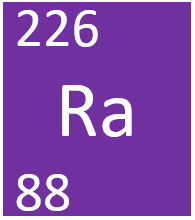Difference between revisions of "Radium"
(→About Radium) |
|||
| Line 36: | Line 36: | ||
: [[Radium]] [[Chemical Reaction|reacts]] strongly with [[water]] to produce [[Hydrogen]] [[gas]] and [[Radium Hydroxide]] and strongly with [[acid]] to produce [[Radium]] [[salt]]s. | : [[Radium]] [[Chemical Reaction|reacts]] strongly with [[water]] to produce [[Hydrogen]] [[gas]] and [[Radium Hydroxide]] and strongly with [[acid]] to produce [[Radium]] [[salt]]s. | ||
: [[Radium]] is a [[solid]] at [[STP|standard temperature and pressure]]. | : [[Radium]] is a [[solid]] at [[STP|standard temperature and pressure]]. | ||
| + | |||
| + | |||
| + | ===References=== | ||
| + | ====AQA==== | ||
| + | |||
| + | :[https://www.amazon.co.uk/gp/product/0008158770/ref=as_li_tl?ie=UTF8&camp=1634&creative=6738&creativeASIN=0008158770&linkCode=as2&tag=nrjc-21&linkId=ec31595e720e1529e49876c3866fff6e ''Radium, page 110, GCSE Physics; Student Book, Collins, AQA ''] | ||
Revision as of 23:29, 10 November 2019
Contents
Key Stage 2
Meaning
Key Stage 3
Meaning
Radium is a Group 2 element, on the Periodic Table, with an atomic number of 88.
About Radium
Molecular Structure
- Radium has the chemical formula Ra.
- Radium atoms join together in large numbers to form a giant metal molecule.
Atomic Structure
- Radium as 88 protons and 138 neutrons in its nucleus giving it an Atomic Number of 88 and an atomic mass of 226.
- An atom of Radium has only 2 electrons in its outer shell.
Properties
- Radium is the most reactive alkali earth metal.
- Radium is more reactive than Carbon on the reactivity series so it must be extracted from its ore using electrolysis.
- Radium reacts strongly with water to produce Hydrogen gas and Radium Hydroxide and strongly with acid to produce Radium salts.
- Radium is a solid at room temperature.
Key Stage 4
Meaning
Radium is a Group 2 element, on the Periodic Table, with 88 protons in the nucleus.
About Radium
- Radium was discovered by Marie Curie.
Molecular Structure
- Radium has the chemical formula Ra.
- Radium atoms join together in a giant metallic structure.
Atomic Structure
- The most stable isotope of Radium has 138 neutrons in its nucleus giving it an atomic mass of 226.
- An atom of Radium has only 2 electrons in its outer shell.
- Radium ions have lost two electrons to become positively charged.
Properties
- Radium is the most reactive alkali earth metal.
- Radium is more reactive than Carbon on the reactivity series so it must be extracted from its ore using electrolysis.
- Radium reacts strongly with water to produce Hydrogen gas and Radium Hydroxide and strongly with acid to produce Radium salts.
- Radium is a solid at standard temperature and pressure.
